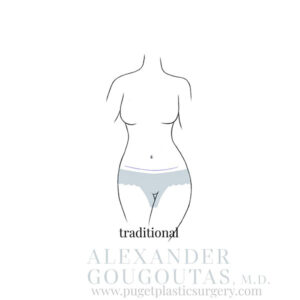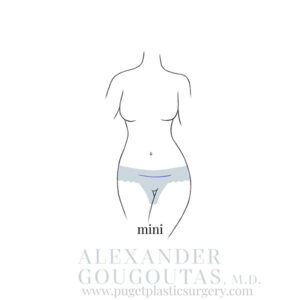November 03, 2025 | 7 minute read
If you are considering a tummy tuck, you can probably picture your ideal results. But then, another thought creeps in: What about the scars? This is one of the most common concerns patients have before surgery. The fact is, incisions and their subsequent scars are an inevitable part of undergoing a plastic surgery procedure. However, with modern techniques and an experienced plastic surgeon by your side, tummy tuck incisions can be placed in discreet areas, making scars barely noticeable once they are fully healed.
Types of Tummy Tuck Scars


Traditional Tummy Tuck
During a conventional tummy tuck, a horizontal incision is made across the lower abdomen, usually from one hip to the other. This incision gives your surgeon more access to remove excess skin, tighten muscles, and reshape the midsection. Usually, the tummy tuck scar sits slightly above the pubic area and can easily be covered by underwear or a swimsuit. Another incision might be made around your belly button if it needs repositioning. This will result in a minor scar that easily blends in with your tissue when it is fully healed.
High Lateral-Tension Abdominoplasty (HLTA)

Besides traditional tummy tucks, Dr. Alexander Gougoutas also offers the high lateral-tension abdominoplasty (HLTA). This advanced technique differs from the conventional procedure in the following ways:
- The incision is positioned lower on the body compared to the traditional tummy tuck, making it easier to conceal, even in your favorite bikini bottoms. To see the difference, explore the tummy tuck before and after gallery.
- Because the incision is lower, a small vertical incision may be required.
- The HLTA technique distributes tension across the thighs, not in the midline of the stomach. This prevents the scar from moving too high above the underwear line.
- Generally, the tension created by this incision helps eliminate excess skin on the thighs and hips, resulting in a mini-thigh lift, with an overall improved contour when compared to a conventional tummy tuck.
Mini Tummy Tuck

A mini tummy tuck incision is located in the same place as a conventional tummy tuck incision; however, it is typically much shorter.
- Ideal patients for a mini tummy tuck are those with only a small “pooch” of extra skin/fat below the belly button.
- A scar around the belly button is usually not required.
- Repair of a diastasis recti (separation of the abdominal six-pack muscles) is usually not performed with a mini tummy tuck.
- Recovery following a mini tummy tuck is much shorter compared to a conventional tummy tuck.
Fleur-de-Lis Tummy Tuck

In addition to the scar created by a conventional tummy tuck, a fleur-de-lis abdominoplasty places a vertical scar from the breast bone to the midline. Dr. Gougoutas may recommend this type of tummy tuck if you have a significant amount of skin laxity that cannot be completely removed by a traditional tummy tuck.
- Though it varies from patient to patient, a fleur-de-lis abdominoplasty is generally recommended for patients with very significant skin excess, such as is seen following massive weight loss (>45 to 50 pounds).
- The vertical incision seen in a fleur-de-lis tummy tuck does not generally require any increased recovery or healing time compared to a conventional tummy tuck.
- In almost all cases of a fleur-de-lis abdominoplasty, the belly button can be saved.
Reverse Tummy Tuck

Unlike a conventional tummy tuck that pulls excess tissue down and places the scar within the bikini line, a reverse abdominoplasty pulls tissue up and places the incision within the folds under the breasts.
- A reverse tummy tuck is recommended for patients with upper abdominal (epigastric) skin laxity that cannot be adequately treated with a conventional tummy tuck.
- Depending on the amount and location of skin laxity, a reverse tummy tuck alone may dramatically improve contour. In some cases, both a conventional tummy tuck and a reverse tummy tuck may be required for maximal contour improvement, though these surgeries would not be performed at the same time.
Abdominoplasty and Belly Button Scars
Not every tummy tuck requires a scar around the belly button. In general:
- When a belly button incision is required, it is placed within the natural contour of your belly button so the resulting scar is maximally hidden.
- Mini tummy tucks do not require a scar around the belly button.
- Conventional tummy tucks almost always require a scar around the belly button.
- Healing of the belly button scar may take 7 to 10 days longer than healing of the main tummy tuck scar.
Tummy Tuck Scar Healing Tips
While you cannot avoid tummy tuck scars entirely, here are some steps you can take to enhance healing and promote scar fading:
Wear Compression Garments
Compression garments reduce fluid buildup and swelling by applying steady pressure to the surgical area, supporting the healing of tissues and muscles. This prevents complications such as seromas and may reduce bruising, swelling, and pain.
Use Silicone Scar Sheets and Gels
Scar sheets and gels reduce scar size, texture, and color by maintaining hydration, which also relieves pain and itching. Use these scar reduction products only after your incision has fully closed and you receive clearance from Dr. Gougoutas.
Practice Gentle Scar Massage
Once cleared by Dr. Gougoutas, you can practice gentle scar massage techniques to break down scar tissue and enhance circulation. You can perform scar massage as an at-home technique or visit a professional.
Protect Your Scar From the Sun
UV exposure can darken your scars. Use sunscreen with a minimum of SPF 30 or cover your incision sites when you are outdoors.
It is a common misconception that only visible light can darken scars. This is not true. Even on cloudy days, there may be an abundance of UV light, which is the real culprit when it comes to darkening scars. Remember to apply your sunscreen throughout the day (even if it is cloudy), and reapply throughout the day!
Tummy Tuck Scar Recovery Timeline
As your body heals and recovers, your incision sites will close and the resulting scars will fade, becoming almost unnoticeable in one to one-and-a-half years with proper care. Here is what you can expect:
- Immediately After Abdominoplasty: The incision(s) will be red, swollen, and raised as your body begins the healing process.
- One Month Post-Op: The scar may appear darker (purple and deep pink) and feel itchy and stiff, which is a regular part of the healing and rebuilding process.
- 2 to 6 Months: The scars begin to flatten and start fading into a light brown or softer pink color.
- 6 to 12 Months: Your scars will begin to blend naturally with your skin, becoming fainter and less raised over time.
- 12 to 18 Months: Your scar is considered mature and fully healed, but can continue to fade and soften over time.
- 5 Years and Beyond: The scar becomes significantly inconspicuous, with its color almost matching your skin tone.
Scar healing time can vary depending on factors such as your age, skin type, and post-op care. Remember that patience is key, as it can take up to a year for your scar to fully heal and fade.
Interested in a Tummy Tuck in Seattle, WA?
If you are considering a tummy tuck procedure, Dr. Alexander Gougoutas and his team have you covered. We are here to provide quality and personalized care you can rely on. Whatever your needs, contact us at (206) 320-6138 or complete our online contact form to schedule a consultation.
